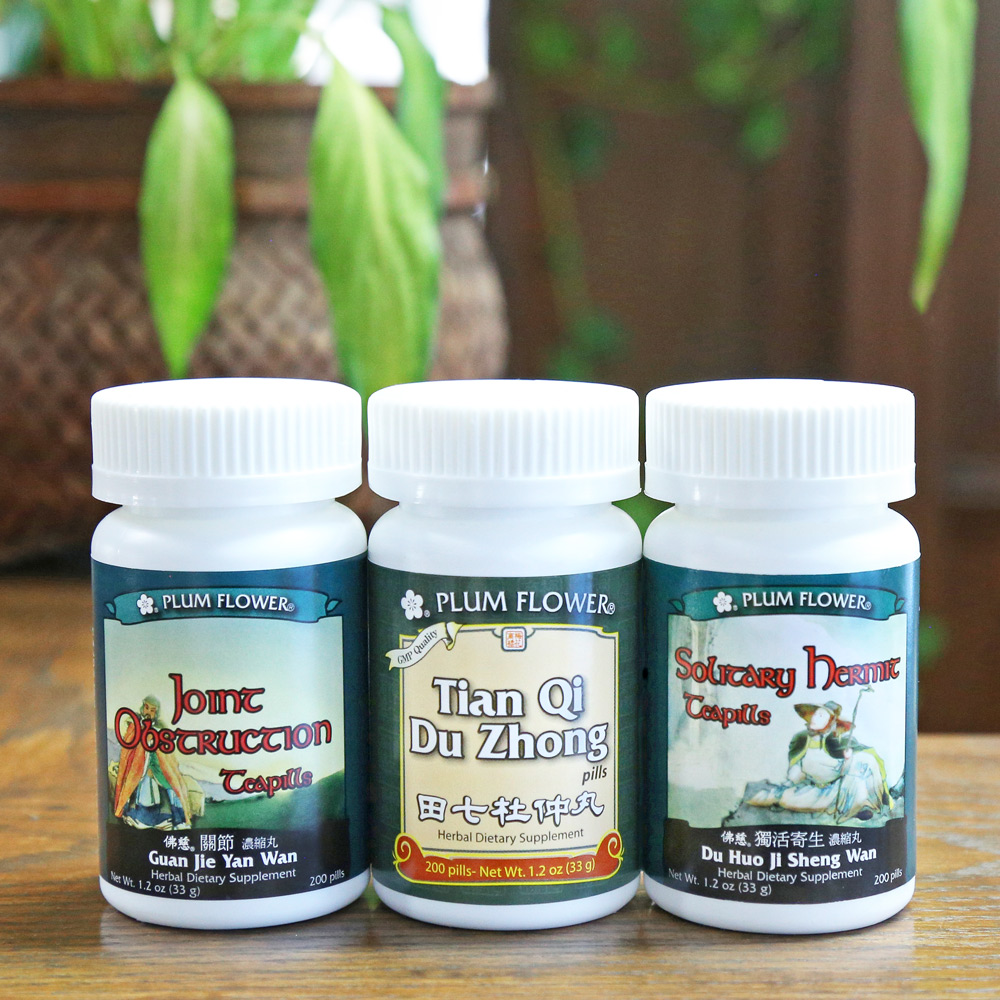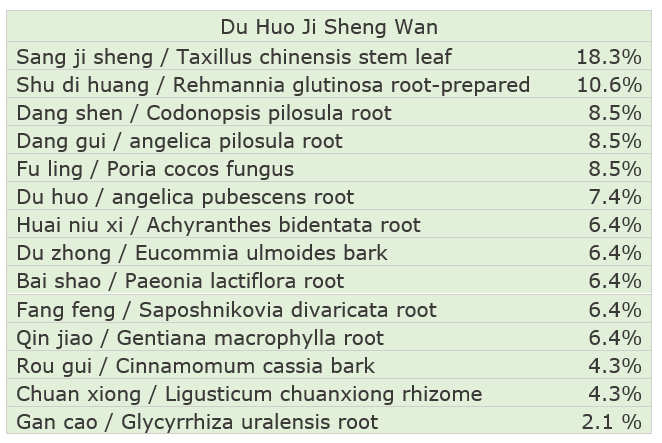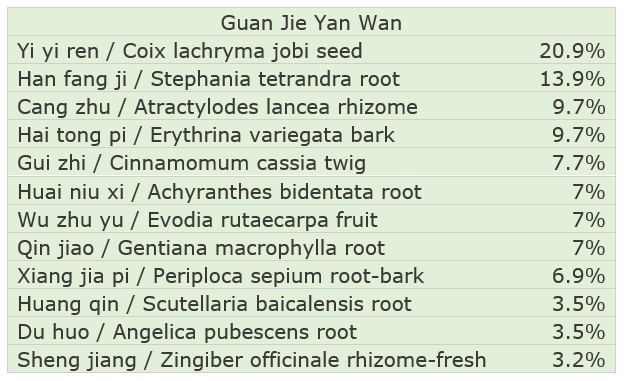Musculoskeletal Discomfort Formulas

In TCM practice in the US today, chronic and acute musculoskeletal complaints comprise a large percentage of patients seen, and much of acupuncture's acclaim and acceptance is the result of our success in this area. When diagnosed correctly, inclusive of allopathic diagnostic and historical information derived from MRIs and X-rays, acupuncture can be a very effective modality for pain reduction and a patient’s return to more functional movement. The addition of herbal prescriptions to enhance the healing process provides an even more restorative treatment strategy to relieve muscle, tissue and joint discomfort.
As with all clinical treatment, syndrome pattern differentiation is essential. With musculoskeletal complaints, we need to discern whether muscle or connective tissues, including tendons and ligaments, are the primary cause since they are treated differently. From the perspective of Traditional Chinese herbal medicine, treating connective tissue involves opening and circulating of the channels and collaterals to eliminate Wind, Cold, Heat, Dryness or Dampness, while muscle tissue generally requires the additional treatment principle of moving Blood. What follows is a quick practitioner's guide to three of Mayway's most popular herbal prescriptions for musculoskeletal discomfort.
Du Huo Ji Sheng Tang/Wan
The original source for this herbal prescription is Sun Si-Miao's Bei Ji Qian Jin Yao Fang, Prescriptions Worth a Thousand Pieces of Gold for Emergencies, compiled during the Tang Dynasty. This formula treats Bi Zheng; Painful Obstruction Syndrome, due to the accumulation of Wind, Cold and Dampness with underlying Liver and Kidney weakness and Qi and Blood Deficiency. The etiology of this condition can be either the result of prolonged environmental exposure to wind, cold and damp, which obstructs Qi and Blood circulation and leads to underlying organ deficiencies, or from underlying Liver and Kidney deficiencies that allow Wind, Cold and Dampness to obstruct the channels and collaterals. In either case, this prescription treats the mixed picture of exterior excess with underlying deficiency.

Du Huo Ji Sheng Tang is a time-honored formula for chronic Bi Syndrome. Though originally developed to primarily treat the low back and lower extremities, it is equally effective in treating neck, shoulder, and upper extremity obstruction as well. It's essential to note that eight of the herbs in the prescription are tonifying herbs from the Qi, Blood and Yang/Warm Interior categories, so the clinical picture for this formula is essentially one of interior deficiency. As such, Du Huo Ji Sheng Tang is particularly suited for patients with chronic Bi Syndrome that comes and goes, or that re-emerges in the late Fall and Winter, or is exacerbated by exposure to acute exposure to wind, cold and damp.
Since the actions of this formula are primarily tonifying, its ability to eliminate acute Wind, Cold and Dampness symptoms can be significantly enhanced by combining this prescription with Guan Jie Yan Wan. For patients who fit this clinical presentation, the prescription can be taken long term, even when they are not experiencing acute Wind Cold Damp Bi symptoms.
Dosage: 8-10 pills, 3 times daily. For extract powders, 3 grams 3 times daily. Cautions & contraindications: Contraindicated during pregnancy, early stages of acute colds or flu, and during acute infection. Use with caution in excess conditions, Yin deficiency Heat, and Phlegm and Damp stagnation.
Guan Jie Yan Wan
Joint Obstruction Pills are a modern prescription formulated to treat Damp Heat Bi syndrome primarily affecting the joints of the lower extremities. Although half of the prescription is comprised of warm herbs, the overall effect of the formula is cooling. Due to the presence of significant Dampness in this clinical picture, warm mobilizing herbs are particularly useful, as Dampness is fundamentally a Yin pathogen. Cang zhu, Hai tong pi, Gui zhi, Wu zhu yu, Du huo, and Sheng jiang function to warm, open and circulate the channels and collaterals while eliminating Dampness. The bland, bitter and cold Dampness-clearing herbs Yi yi ren and Han fang ji make up 34% of the prescription, while the remaining cool Dampness draining herbs Huai niu xi, Qin jiao, Xiang jia pi and Huang qin assist in clearing Heat and reducing Dampness and swelling.

Guan Jie Yan Wan is a strong prescription for eliminating swelling and achiness associated with Damp Heat Bi. Appropriate for both acute and chronic clinical pictures, the primary effect of the formula is one of eliminating excess. In treating mixed excess/deficiency patterns, Guan Jie Yan Wan can initially be administered by itself. Once significant progress is made to eliminate the excess presence of Damp Heat, continued use should be in combination with tonic formulas selected to address the underlying etiology of the condition.
Dosage: 8 pills, 3 times daily. In severe cases, or initial phases of treatment, dosage may be increased up to 12 pills 3 times daily. Cautions & contraindications: Contraindicated during pregnancy. Contraindicated during early stages of acute illness such as cold and flu, and during acute infections.
Tian Qi Du Zhong Wan
This modern prescription was specifically formulated to treat acute or chronic low back ache, which is one of the most common complaints seen in clinical practice. In addition, there are other applications for this prescription that are not often listed in contemporary TCM literature. As noted above, when treating musculoskeletal complaints, it is essential to determine whether it is originating from connective tissue or muscle tissue. This differentiation is important as the herbs used for treatment of Wind Cold or Damp Bi Syndrome are best for warming, opening, and resolving channel blockage, while the addition of blood vitalizing herbs is required when treating muscles.

The prescription includes Tian qi, Du zhong, Rou gui and Ru xiang. Comprising 54% of the prescription, these herbs are included to move the blood and dispel blood stasis in the muscles of the low back. According to TCM theory, sub-acute and chronic muscle ache is referred to as Qi and Blood stagnation due to Qi and Blood deficiency. Accordingly, Ren shen, Du zhong and Sang ji sheng are found in the formula to nourish Qi, Blood and Yang in order to eliminate stagnation through tonifying the underlying deficiencies. The spicy warmth of Du huo dispels Wind, Cold, and Dampness, relieves obstruction, and functions as a guiding herb to the low back. Finally, Wu wei zi tonifies the Kidneys, secures Essence, generates fluids, and strengthens the low back.
In addition to treating low back issues, Tian Qi Du Zhong Wan is effective in treating muscle ache and spasm anywhere in the body. This prescription is an excellent complement to acupuncture treatment and can be used to treat a wide variety of sports injuries where muscle ache is the primary complaint. Finally, for those patients with more significant Qi and Blood deficiency, Tian Qi Du Zhong Wan can be combined with Qi and Blood tonic formulas.
Dosage: 10 pills, 2-4 times daily. Cautions and contraindications: Contraindicated during pregnancy or with hemorrhagic disorders. Use with caution during menses, and those on anti-coagulant therapy.
From a TCM perspective, even though acute and chronic musculoskeletal complaints differ in origin and severity, it is important to remember that treatment most always involves not only resolving discomfort, but also treating the underlying deficiencies of Qi Blood, Yin or Yang, along with Blood stagnation and accumulation of Dampness from internal or external influences. TCM herbal formulations, alongside the combination of Eastern and Western diagnostic principles, will greatly enhance your patients’ ability to return to the activities that they enjoy!
References
- Bensky, D. et al., Chinese Herbal Medicine Materia Medica, 3rd ed., Eastland Press: 2004.
- Chen, J. & Chen, T., Chinese Medical Herbology and Pharmacology, Art of Medicine Press: 2004.
- Fratkin, J. P., Essential Chinese Formulas, Shya Publications: 2014.
- Maclean, Will, Clinical Manual of Chinese Herbal Patent Medicines, Pangolin Press: 2003.
- Wrinkle, A. et al., A Practitioner’s Formula Guide, Elemental Essentials Press: 2008.


